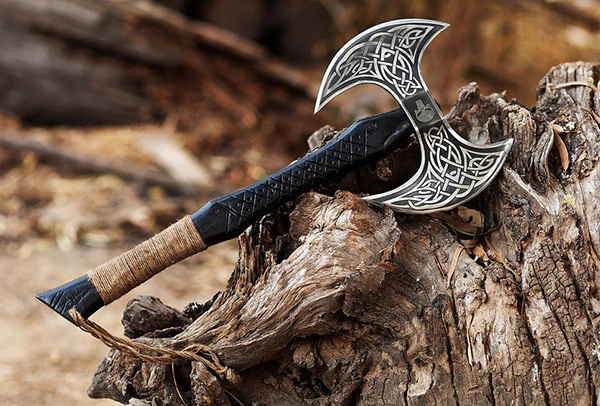When one envisions a Viking warrior, a formidable figure wielding a mighty battle axe often comes to mind. The iconic weapon, known as the Axe of the North, held immense significance in the Norse culture and played a pivotal role in shaping the Viking Age. Beyond its practical utility in combat, the Viking battle axe carried cultural, religious, and symbolic importance that reflected the values and way of life of these seafaring warriors. At the heart of their success in battle was the skillful use of weaponry, with the battle axe emerging as one of their most iconic and versatile tools of war. Viking battle axes came in various designs, each tailored to specific combat scenarios. The most common types included the broad axe and the bearded axe. The broad axe featured a wide, elongated blade suitable for cleaving through shields and armor, while the bearded axe possessed a distinctive hook-shaped blade that allowed for both cutting and hooking actions, ideal for disarming opponents or pulling down shields.
These variations demonstrated the Vikings’ ingenuity in adapting their weaponry to different battlefield needs. The battle axe was more than just a tool for combat—it held deep cultural significance in Norse society. Axes were not only weapons but also symbols of social status and power. A Viking’s axe was often adorned with intricate carvings and decorations, showcasing the owner’s craftsmanship and enhancing the weapon’s aesthetic appeal. Moreover, the axe was frequently used as a grave offering, signifying its importance even in the afterlife. In Norse mythology, the battle axe held a prominent place as well. These representations reinforced the axe’s association with strength, protection, and divine favor, further solidifying its significance in the hearts of Viking warriors. The practicality and effectiveness of the battle axe in combat cannot be overstated. Its versatility allowed Vikings to engage in both close combat and ranged attacks, making them formidable opponents on the battlefield.

Whether used for cleaving through enemy lines or throwing with deadly accuracy, the battle axe’s design catered to the Vikings’ aggressive and tactically agile fighting style. Viking raiders and warriors were often buried with their weapons, including their trusty battle axes. Archaeological discoveries of these ancient burials have provided invaluable insights into the craftsmanship, design, and evolution of Viking weaponry. The artifacts unearthed from these gravesites have shed light on the skill of Norse blacksmiths and the cultural significance of these weapons. The Axe of the North holds a special place in Viking history and culture. Beyond its role as a fearsome tool of war, it symbolized strength, power, and divine protection. The wikinger axt kaufen design versatility, cultural importance, and mythological connections all contributed to its iconic status. As we delve into the annals of history, the Viking battle axe stands as a testament to the ingenuity and indomitable spirit of the Norse people during an era of exploration, conquest, and cultural exchange.

